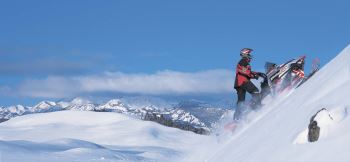 Ten thousand dollars.
Ten thousand dollars.
Walk into your local dealer and drive away with a brand new sled in tow for less than $10k: while that's not impossible, it is kind of tough to do. New sled prices are getting up there these days and while they may be worth it, what with the newest technology and advances in the industry and all, for some of us, spending that kind of money on a weekend hobby just isn't an option.
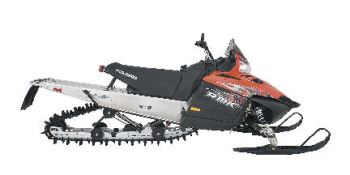 So let's talk about the used snowmobile market a little, focusing on the mountain sleds from the past five years. What sleds are holding the best value? Which models should you keep an eye out for? If you've got a used sled, is it one worth hanging on to? While we haven't done any cold, hard research with proven scientific formulas, we have spent some time talking with a few folks in the industry and looking through the used value books.
So let's talk about the used snowmobile market a little, focusing on the mountain sleds from the past five years. What sleds are holding the best value? Which models should you keep an eye out for? If you've got a used sled, is it one worth hanging on to? While we haven't done any cold, hard research with proven scientific formulas, we have spent some time talking with a few folks in the industry and looking through the used value books.
 Which models out there are worth looking into if you want to buy this season? What models have reliable, consistent platforms, sleds that are still capable in the backcountry while not killing the pocket book?
Which models out there are worth looking into if you want to buy this season? What models have reliable, consistent platforms, sleds that are still capable in the backcountry while not killing the pocket book?
We'll start with the Edge chassis Polaris RMKs. The Edge chassis was a solid platform that helped Polaris continue its mainstay at the top of the hill here in the western market. The chassis is tough, reliable and very agile in the deep stuff. Rock solid powerplants and consistent reliable Team clutches make the Edge models more than capable to take you everywhere you need to go. No matter what the engine size, whether it is the potent 800cc, rock solid 700cc or very peppy 600cc, the Liberty engine is a solid core to a great deep powder machine.
Revved Up
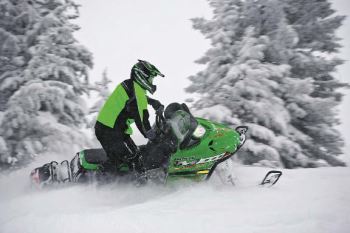 Next is the 2004-07 Ski-Doo Rev, the chassis that changed the way we ride. Introducing the first true rider forward technology on these sleds improved a rider's ability to control a machine in ways never thought imaginable. Placing the strong 800cc motor lower and further back in the chassis allowed for better balance and a more comfortable feel for most riders. That design change made stand-up style mountain riding even easier. The chassis is light, very maneuverable and is still more than enough sled to keep up with just about every new sled on the market. The early 800 models had some issues with piston ring failure, but that's an easy fix in most cases.
Next is the 2004-07 Ski-Doo Rev, the chassis that changed the way we ride. Introducing the first true rider forward technology on these sleds improved a rider's ability to control a machine in ways never thought imaginable. Placing the strong 800cc motor lower and further back in the chassis allowed for better balance and a more comfortable feel for most riders. That design change made stand-up style mountain riding even easier. The chassis is light, very maneuverable and is still more than enough sled to keep up with just about every new sled on the market. The early 800 models had some issues with piston ring failure, but that's an easy fix in most cases.
 Another great sled to keep your eyes open for is a well-maintained M7 from any year. The M7 really put Arctic Cat back in the fight when it came to new chassis rider forward design. The M Series platform is a comfortable, proven chassis with great mountain ergonomics. The sled really excels in deep powder boondocking and is no slouch on a long steep climb. With the proper clutching set up and EFI injection, the M7 will run great day in and day out. These sleds flooded the market in 2005-06, meaning there are plenty of them out there.
Another great sled to keep your eyes open for is a well-maintained M7 from any year. The M7 really put Arctic Cat back in the fight when it came to new chassis rider forward design. The M Series platform is a comfortable, proven chassis with great mountain ergonomics. The sled really excels in deep powder boondocking and is no slouch on a long steep climb. With the proper clutching set up and EFI injection, the M7 will run great day in and day out. These sleds flooded the market in 2005-06, meaning there are plenty of them out there.
Now let's spend some time on used sleds from a seller's standpoint. Matt Hasara, of Powerhouse 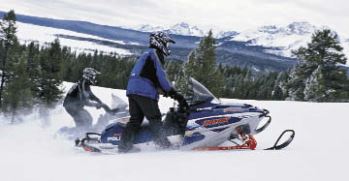 Motorsports in Lindon, UT, a shop that deals solely in used sleds, has seen hundreds of good used machines come and go from his showroom floor.
Motorsports in Lindon, UT, a shop that deals solely in used sleds, has seen hundreds of good used machines come and go from his showroom floor.
After speaking with Hasara, looking for a little `insiders' look of the used sled market, we learned some very interesting points. "When it comes to used machines, I've found that the closer to stock the sled is, the easier time I have selling it," he says. "The aftermarket is a huge part of the snowmobiling industry, but when it comes down to it, if you think your used sled will be worth more because of the $1,500 in parts you've put on it, you're in for a big disappointment."
Big, Dark Black Hole
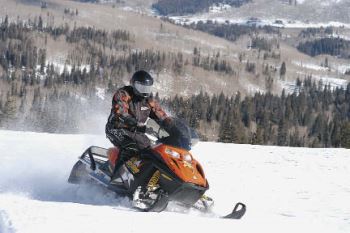 He looks at it like a "big, dark black hole." He said, "When buying aftermarket parts for your snowmobile you should look into them for the sole purpose of your further enjoyment of the machine. Outside of the improvements they make to your sled, aftermarket parts will not increase its value, at least not as much as you've invested in them."
He looks at it like a "big, dark black hole." He said, "When buying aftermarket parts for your snowmobile you should look into them for the sole purpose of your further enjoyment of the machine. Outside of the improvements they make to your sled, aftermarket parts will not increase its value, at least not as much as you've invested in them."
Hasara says that is one of the biggest misconceptions he sees from customers when they walk in his shop looking to trade in their current sled for a  newer model. "A $600 set of pipes won't make it worth $600 more when it comes time to sell," he explained. "If you're going to buy pipes, do it because you want them and are looking to improve your sled's performance. Otherwise it's just money tossed into that big black hole."
newer model. "A $600 set of pipes won't make it worth $600 more when it comes time to sell," he explained. "If you're going to buy pipes, do it because you want them and are looking to improve your sled's performance. Otherwise it's just money tossed into that big black hole."
He also told us that if he had two identical sleds with identical miles sitting side by side on the showroom floor and one was 100 percent bone stock and the other had aftermarket parts installed, more often than not the stocker will sell quicker.
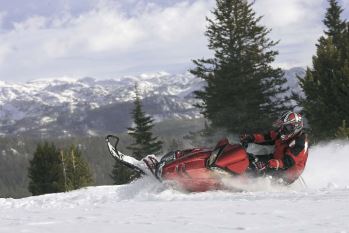 Looking at used snowmobile market values-specifically retail values-you can get a feel for what kind of money you will expect to pay for any given model. How much should you expect to pay for a good-running, well-maintained machine? We spent some time going through the Kelly Blue Book (KBB) and NADA Guides trying to determine what the fair market value on some of these sleds is. It's kind of surprising to see how much variance there is between the two used value books. KBB has almost every model valued lower than the NADA Guide, some of them substantially less.
Looking at used snowmobile market values-specifically retail values-you can get a feel for what kind of money you will expect to pay for any given model. How much should you expect to pay for a good-running, well-maintained machine? We spent some time going through the Kelly Blue Book (KBB) and NADA Guides trying to determine what the fair market value on some of these sleds is. It's kind of surprising to see how much variance there is between the two used value books. KBB has almost every model valued lower than the NADA Guide, some of them substantially less.
Breathing Fire
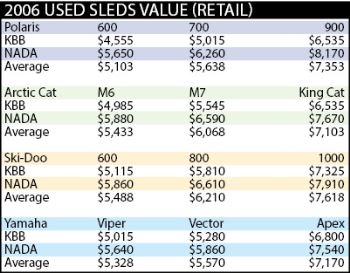 Take the 2007 Polaris Dragon for example. KBB values the machine in good condition at $6,270 while NADA has the sled valued at $7,670. That's a difference of $1,400. Now, this not being actual scientific research, we couldn't come up with a set-in-stone reason as to why there is such a large gap between the two, but the NADA value seems more realistic. As the seller in the transaction of course you'd prefer to use the NADA value, but on the other side of the fence, as a prospective buyer, the KBB values look much more appealing.
Take the 2007 Polaris Dragon for example. KBB values the machine in good condition at $6,270 while NADA has the sled valued at $7,670. That's a difference of $1,400. Now, this not being actual scientific research, we couldn't come up with a set-in-stone reason as to why there is such a large gap between the two, but the NADA value seems more realistic. As the seller in the transaction of course you'd prefer to use the NADA value, but on the other side of the fence, as a prospective buyer, the KBB values look much more appealing.
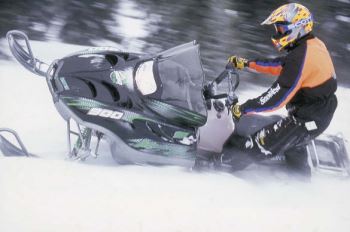 What can be taken from these charts? Are these used sled values really what you could expect to pay for these specific models? Well, when it comes down to it, the snowmobile market is tough to generalize. A slow snow season will definitely affect the value of snowmobiles. It's a natural fact that when we don't have snow, our machines aren't worth much. It's like trying to sell your snowmobile at the end of a season rather than at the beginning of the next. That's where your good friend economics comes into play. Remember that supply and demand curve you learned about in your freshman college course?
What can be taken from these charts? Are these used sled values really what you could expect to pay for these specific models? Well, when it comes down to it, the snowmobile market is tough to generalize. A slow snow season will definitely affect the value of snowmobiles. It's a natural fact that when we don't have snow, our machines aren't worth much. It's like trying to sell your snowmobile at the end of a season rather than at the beginning of the next. That's where your good friend economics comes into play. Remember that supply and demand curve you learned about in your freshman college course?
 Do the used value books take all that into consideration when they determine a snowmobile's value? Back to the supply and demand thing, let's look at the 2005 Arctic Cat M7, a very popular model among western riders when it hit the dealer showrooms in 2005. Even now it is still a very capable backcountry vehicle. Based off the values from KBB and NADA, the average retail price on a used `05 M7 should be right around $5,300. That seems about right but we've seen them go for as little as $4,000 and some are still up around $6,000. But, in general, most seem to be right around that $5,000-5,300 range. There are a lot of these sleds out there, which should have a negative effect on their value. However, demand is still pretty high and even with some higher miles on them they seem to continue to be a reliable powder sled, keeping resale values consistent.
Do the used value books take all that into consideration when they determine a snowmobile's value? Back to the supply and demand thing, let's look at the 2005 Arctic Cat M7, a very popular model among western riders when it hit the dealer showrooms in 2005. Even now it is still a very capable backcountry vehicle. Based off the values from KBB and NADA, the average retail price on a used `05 M7 should be right around $5,300. That seems about right but we've seen them go for as little as $4,000 and some are still up around $6,000. But, in general, most seem to be right around that $5,000-5,300 range. There are a lot of these sleds out there, which should have a negative effect on their value. However, demand is still pretty high and even with some higher miles on them they seem to continue to be a reliable powder sled, keeping resale values consistent.
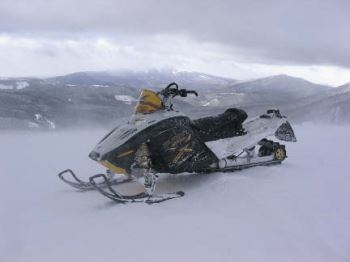 Now look at the listed values for the 2005 Polaris 900 RMK-a model most everyone knows didn't fare too well in the western market. The 900cc powerplant and chassis just didn't meet the expectations of consumers. Initially the hype on the new model was great, but after a few months on the snow the lackluster performance caused its demand to slowly fade away. A local dealer with an overstock of brand new crated 900 RMKs was selling them as a package deal, a brand new 900 RMK and a two-place tilt trailer for $5k. That's pretty cheap when you consider they retailed for more than $9,000 and now it comes with a new trailer. But the NADA still values the machine at over $6,500. That indicates to us that NADA doesn't have a finger on the market-at least the 900 RMK market.
Now look at the listed values for the 2005 Polaris 900 RMK-a model most everyone knows didn't fare too well in the western market. The 900cc powerplant and chassis just didn't meet the expectations of consumers. Initially the hype on the new model was great, but after a few months on the snow the lackluster performance caused its demand to slowly fade away. A local dealer with an overstock of brand new crated 900 RMKs was selling them as a package deal, a brand new 900 RMK and a two-place tilt trailer for $5k. That's pretty cheap when you consider they retailed for more than $9,000 and now it comes with a new trailer. But the NADA still values the machine at over $6,500. That indicates to us that NADA doesn't have a finger on the market-at least the 900 RMK market.
So while the used value books seem spot-on with some mountain models, they may be way overpriced or even underpriced on others. When it comes down to it, if you're in the market for a used snowmobile it won't be worth any more than what you are willing to pay for it.
After all, you're the one who will be making the payments and riding it. The used market is looking to be strong this season and there are plenty of great models out there. Do some of your own research, decide which chassis is going to fit your riding style best, then just keep your eyes open. When you come across the right sled, you'll know it. It'll just come down to haggling out a price both you and the dealer/seller feel comfortable with.